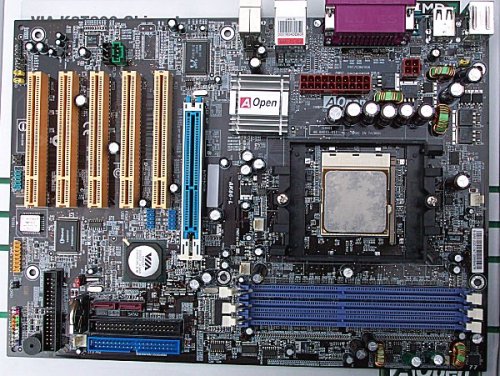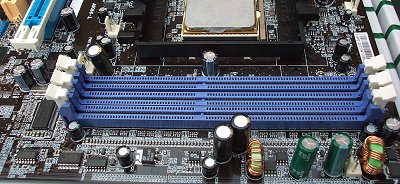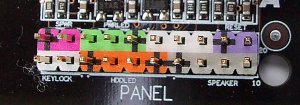Layout and features

AOpen's AK86-L, on first appearance, is a well-designed board. Please note that the CPU retention bracket isn't pre-attached, although that's a 2-minute job at best. Most standard ATX boards measure around 30cm x 24cm. AOpen's decided to make the AK86-L a little narrower at ~22cm, not that you can tell by the intelligent placement of ports and sockets. AOpen judiciously uses colour to separate key features. Installation becomes that much easier.

AOpen's also realised the very simple truth that effective power regulation leads to stable boards. Rubycon, amongst others, provide high-quality capacitors rated up to 3300uF. A bank of such caps surround the retention bracket. Power plugs have been grouped together on the far side. We prefer them alongside the DIMM slots, although the retention bracket is far enough down the board for wires to be tucked up behind it. There's 3 fan headers close by, so cooling has been thought out.

Some K8T800 board designers go with 2 DIMM slots, some go with 3. The inherent problem with specifying three is the inability to run at DDR400 speeds with all slots populated. Slot #3, closest to us, supports a maximum speed of DDR333. It's a controller limitation and the manual clearly spells out the problem. We'd recommend using the first 2 slots with DDR400 modules. We like how system RAM can be removed without having to fiddle with the AGP card. We also like AOpen's card-locking mechanism. It's a simple slider that's easier to disengage than the regular lever. The K8T800 uses two bridges. AOpen passively cools the northern one.

VIA's 8237 Southbridge brings native SATA support to the features table. You can see the associated ports close by. The narrowness of the board has forced the primary and secondary IDE ports to be pushed down. This actually makes the board and PC tidier. We also like the fact that the CMOS jumper is easily accessible. Too many manufacturers decide to lodge it between PATA ports, making the removal of a standard jumper (not ABIT's excellent big-headed ones) a chore. The vertically-mounted battery is a nice touch.

Another small point worth making is the nature of the case-to-motherboard pins. All too often the pins' background is white, so identifying what does what is irksome. A little color makes it appreciably easier. AOpen shows that colour is not just an aesthetic issue; it has practical benefits. Subjectively speaking, the first PCI slot is too near the AGP port. Most cards' coolers will obscure PCI card placement.
Closer inspection of the PCB reveals silkscreening of features. Our AK86-L sample is devoid of FireWire support. It's not present on the Southbridge and no discrete controller is included. Considering the relatively low cost of implementing it, AOpen's been a little stingy, we feel.

The 'stingyness' is pervasive. Realtek's ALC655 CODEC, which is inferior to the long-standing ALC650, is just adequate for 6-channel sound. To AOpen's credit, there's a S/PDIF header nearby.

Feature redemption is almost complete with Realtek's PCI-based Gigabit Ethernet controller, although we'd have taken 100Mbit LAN and FireWire support. The obvious difficulty of this kind of Ethernet connection is the ability to swamp the PCI bus threshold if other cards are used concurrently. Add in USB 2.0 support and the bridge interconnect begins to look meagre.

Pretty regular here. A mixture of old and new. FireWire is conspicuous by its absence. Overall, though, the layout and feature set is good, especially at the sub-£75 price tag that AOpen is positioning the AK86-L at.









